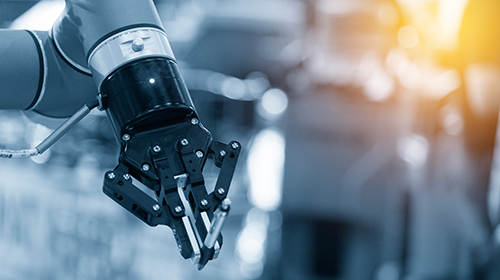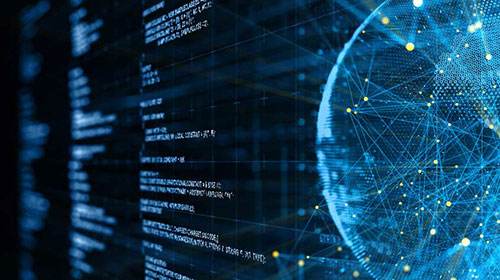Artificial Intelligence and Intellectual Property: An Interview with Francis Gurry
January 22, 2019
WIPO is launching the first installment of its new “Technology Trends” research series on Thursday, January 31, with a focus on artificial intelligence (AI). This revolutionary technology is rising fast and will have profound impacts in all spheres of life, the report will show. Policy responses require a strong factual foundation, which will be provided by the AI-focused Technology Trends study.
Ahead of the launch, WIPO Director General Francis Gurry shares his views on the implications of AI for intellectual property (IP) law and policy and its use in the administration of IP systems around the world.

How would you characterize the impact of AI?
AI is a new digital frontier that will have a profound impact on the world. It will have enormous technological, economic, and social consequences and is going to transform the way we produce and distribute goods and services, as well as the way we work and live.
What impact will AI-enabled technologies have on innovation and creativity?
It is too early to say, but it is clear that AI will have an impact on traditional IP concepts. Commercial AI-generated music and AI-created inventions are not far off, and will transform the concepts of the “composer,” “author,” and “inventor” – although precisely how is not yet clear.

The deployment and use of AI technologies will have implications both for intellectual property law and policy and the administration of IP systems around the world.
WIPO Director General Francis Gurry
The fundamental goals of the IP system have always been to encourage new technologies and creative works, and to create a sustainable economic basis for invention and creation. From a purely economic perspective, if we set aside other aims of the IP system, such as “just reward” and moral rights, there is no reason why we shouldn’t use IP to reward AI-generated inventions or creations. But this still requires some thought. The answers are not yet clear.
The broad use of AI technologies will also transform established IP concepts – patents, designs, literary and artistic works, and so on. This is already happening, but is a consequence of the digital economy, not AI alone. For example, the life sciences generate enormous quantities of data that have significant value but don’t constitute an invention in the classical sense. So we need to work out the rights and obligations that attach to them.
There are strong social views on this already. The “open” movements for science, data, and publication, for example, favor the view that data should not have proprietary categories placed on them. They argue that, as data is a foundation of AI, it should be freely available to enable the development of AI and other applications.

AI is a new digital frontier that will have a profound impact on the world.
WIPO Director General Francis Gurry
But, of equal importance in the current economic context, we have established property rights for intangibles to provide incentives for investment in the creation of new knowledge and to ensure fair competition.
These two approaches need to be reconciled. Lines will have to be drawn between the need to keep channels of data open and flowing, on the one hand, and the need to close them to ensure the right incentives are in place for the creation of new knowledge, on the other hand.
Data and algorithms raise a number of fundamental IP-related questions. For example, how do you create property rights in an algorithm that is constantly changing, to the extent that your invention is not the same even one year after you have applied for a patent? That’s a new challenge that we shall have to address.
Does that mean that the existing IP system is becoming irrelevant?
The statistics tell us otherwise. Demand for IP rights continues to surpass economic growth rates around the world. The IP system as we know it is certainly not going out of fashion. It is being used more than ever before. But new challenges are emerging and the result may be an additional layer of IP, rather than the replacement of the existing system.
It has been notoriously difficult for creators to capture the value of their work in the digital environment. Will the new wave of digitization compound this problem?
AI may indeed make it difficult for creators to capture the value of their work. But, if you take the example of AI-generated music, somewhere in the process the digital expression of music generated by a composer – whether it be Mozart, Beethoven, or a contemporary musician – will be fed into the AI algorithm. The question is at what stage do we attribute value to the human origin of data? We don’t yet have the answers to that question.
Various policy approaches are emerging for data and AI, including in relation to data security and integrity, the impact of data and AI on market competition, national security, labor, and ownership. We are only now developing the lines of analysis, but these tend to reflect pre-AI approaches. No doubt, new categories will emerge too.
Why has AI become a priority for WIPO and the global IP community?
There are three factors driving the use of AI in the administration of IP systems. The first is volume. In 2016, the last year for which data are available, around 3.1 million patent applications, some 7 million trademark applications, and 963,000 industrial design applications (covering 1.2 million designs) were filed worldwide. That volume is rapidly exceeding the processing capacity of available human resources. For example, in the area of trademarks and designs, the judgment, whether made by an IP office or a court, as to the registrability of a trademark or a design – the benchmarks of which are distinctiveness for a trademark and originality for a design – is made by reference to pre-existing marks and designs. It is simply not possible for a human to sift through the millions of trademark and design applications received each year to determine whether a given trademark or design qualifies for registration.
That is why WIPO has developed an AI-empowered image search tool for trademarks. Embedded in the WIPO Global Brand Database, the tool is a world first. It delivers results in a second and is highly accurate.
Volume is a principal driver of the use of AI in IP administration. Quality and cost are also important drivers. Amid increasing global demand for IP rights, AI tools allow us to achieve better quality and reduce administration costs.
What is your vision for the use of AI to improve the administration of IP?
AI systems will play an increasingly important role in IP administration in the future. Given the costs associated with gathering and cleaning large corpuses of data to feed AI-systems, we need to encourage the sharing of resources. I would hope that in deploying the AI-based systems of the future, the international IP community can work together to achieve high levels of interoperability in a cost-effective manner.

of outputs, and to reduce the costs of IP administration, are key drivers of the use of AI
in the administration of IP systems. (Photo: MF3d / iStock / Getty Images Plus)
WIPO’s approach so far has been to explore ways to develop AI applications using training data provided by member states and other institutional partners.
In return, we share with those partners any new AI applications developed using those data.
For example, WIPO has developed a state-of-the-art neural machine translation tool that is powered by AI, known as WIPO Translate. We are sharing this tool with 14 intergovernmental organizations and various patent offices around the world. Since the system depends on access to and availability of data, all partners can benefit from its use and can supply data to improve it. That is how, in the best of all possible worlds, we might develop these tools most effectively.
WIPO has clearly been a leader in developing AI applications in the IP field. Is the Organization exploring the use of AI applications in other areas?
WIPO is continuing to develop and refine WIPO Translate and our trademark image search tool. These are major developments in this area. The automatic classification of patents and goods and services for trademark applications are other promising areas for the application of AI. In May, in collaboration with an AI expert at the University of Geneva, WIPO launched an automatic patent classification tool for the International Patent Classification (IPC) system using neural network technology. This new tool, known as IPCCAT-neural, will be retrained annually with updated patent information and will help patent examiners access and search “prior art” more easily. This, of course, is an important basis for determining the patentability of an invention.
AI holds great promise in facilitating patent search and examination. One can foresee its use, for example, in searching and comparing the gene sequences associated with certain patent applications.
We are also exploring the use of AI, in particular, the deployment of intelligent machine answering services, for WIPO’s customer service activities. Over time, these tools will become an integral part of our customer service offering and will enable us to better respond to the expanding number of queries arising from the increasing use of the IP system.
There will be other areas in which AI applications can help make IP administration more efficient and robust.
Is there a role for Blockchain in the administration of IP systems?

Despite the widespread excitement about Blockchain, I don’t see it replacing the basic function of the grant of a property right by a state or a public authority.
IP is a creation of the state, and unlike physical property, it has no existence except through the creation of a right by a state.
I don’t see a private distributed system like Blockchain replacing that basic function of patent offices in determining whether or not to grant a property right. I do see it being a potentially superior form of recording transactions in relation to existing IP rights. There are, for example, many potential applications for Blockchain in the use and trading (e.g. licensing) of IP rights.
How would you characterize the uptake of AI across the global IP community?
It is early days. There is clearly a lot of interest in AI among IP offices, which see it as an opportunity to deal with volume, quality and cost. This will be a major focus in the coming months and years.
What are some of the barriers to the widespread deployment of AI-powered systems among IP offices?
Building AI capacity is a major challenge for all IP offices. While AI has been around for some time, only recently has it become an obvious technological solution. The number of professionals with the required training and knowledge is very limited. This makes developing in-house AI capacity difficult, particularly in the face of competition from better-resourced, higher-paying private enterprises.
Smaller IP offices face some specific challenges. AI systems depend on data (and algorithms) and smaller offices naturally have access to less data. That means the imperative of volume, which is forcing the development and deployment of AI applications in larger offices, is less strong in smaller offices, where the volume of applications remains manageable. That said, in the IP world, we do have a generally accepted policy of open access to data relating to IP registrations for patents, trademarks and designs. That will help the smaller IP offices, which, in principle, can access these data. Overcoming these challenges will require greater emphasis on collaboration and coordination.
What are some of the specific policy challenges associated with deploying AI for IP administration and how is WIPO addressing them?
This year, WIPO initiated an international discussion on IP questions surrounding, in particular, the application of AI in IP administration. In May, we hosted a meeting with IP offices on that subject. It was a successful start to this important discussion.
The broader question of how AI will change the categories and concepts of IP itself, however, is taking place at a time when the world is putting less energy into multilateral rule-making than at any point over the last 70 years. This is a serious problem that goes beyond IP, but especially needs to be solved in this area, because IP is essentially a global phenomenon; technology is global, as are the patent data associated with it. Patents rarely relate to a single jurisdiction. That is why we need global solutions that ensure at least functional interoperability.
Is there a role for multilateralism in an AI-driven world?
Yes, and for various reasons. First, achieving functional interoperability of IP systems around the world will require multilateral cooperation. Second, one of the functions of the IP system is to ensure fair competition. Multilateral rule-making is a constructive and positive way to achieve this. And, as IP will be one of the main battle grounds for competition in the future, strong multilateral cooperation is essential. The third reason is that technology is constantly evolving, and at great speed. In this context, multilateralism is an extremely important mechanism for supporting capacity building and sharing to ensure that the technological gaps that exist are not exacerbated. That is a real challenge.
What are next steps for WIPO in this area?
We will continue to foster cooperation in the development and deployment of AI applications for IP administration. And we will continue to find ways to initiate international discussion on the evolution of IP law and policy in an increasingly AI-driven world.